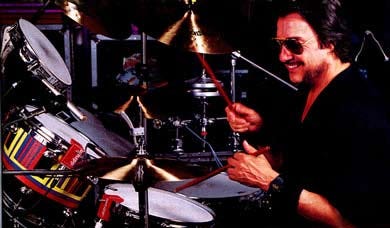Steering without steering: The underappreciated magic of Jim Keltner.
A journey into the lesser-known works by an in-demand session musician.
Here’s where today’s journey started: With a most unusual guitar-plus-sitar treatment of the Rolling Stones’ “Paint It Black” from Hungarian guitarist Gabor Szabo’s 1967 Jazz Raga.
Stones on sitar? Released, evidently quietly, by Impulse? With Bernard Purdie on drums? I took that ride and recommend the whole thing, especially for those who enjoy following music that operates at a slow boil, with placid chords superimposed over long planklike drones.
That made me realize how little I’d heard Szabo, a master guitarist who made a bunch of his own records and worked as a sideman on records by Chico Hamilton, Charles Lloyd and others. Szabo was a lyrical soloist with an excellent ear for pop melody: On his album titled 1969, he does low-key instrumental watercolor versions of the Beatles’ “In My Life,” “Dear Prudence” and others. (That one’s a little more hit-and-miss.)
Searching for Szabo, I read an interesting paragraph on the web outpost of the Chicago record store Dusty Groove that made me think I needed to order Dreams, which came out in 1968. It’s a studio orchestra plus rhythm section affair, with lively writing for strings contrasting with placid lake-at-sunset moods. Pianist Gary McFarland’s arrangements don’t just go for the schmaltzy backdrop setting; some pieces, like the expansive re-imagining of Spanish composer Manual De Falla’s “Fire Dance,” sustain a simmering, perpetually fitful tension across rapid tempo changes, with rhythms jousting like flames lashing at the ankles of ritual dancers.
Dreams is stunning, a project unlike just about everything filed under jazz. It balances wonderfully accessible themes with high concept ideas from the realm academics sometimes call “third stream music” (you’ll have to ask them what the term means). And it has understated rhythm at its center, but in an almost invisible way. They’re crisp pulses, with no ornamentation; the drummer sounds completely locked into the work, in a way that makes the rhythm parts disappear into the total thrust of the track. There, and essential, but not there.
Turns out it’s Jim Keltner. The all-time champion of groove transparency. The foundation for so many enduring records, the man in the hot seat for legendary rock tours. Keltner is the rare rock musician who leads with finesse, whose work is about using the least amount of force to conjure the most amount of groove. He’s a lowkey badass who can make people dance with the delicate tapping of sticks on the hi-hat cymbals – just that and nothing more.
That activated more curiosity: What other underloved works was Keltner, whose career took off after people heard him as part of Joe Cocker’s Mad Dogs and Englishmen band, involved in?
Keltner has a discography that stretches nearly to book length; he’s been the sauce-stirrer for John Lennon (circa Imagine), George Harrison, Leon Russell, Harry Nilsson, the Traveling Wilburys, Ry Cooder, Conor Oberst (Salutations, from 2017) and many others. If you burrow into the (shamefully hidden) credits of this year’s releases, Keltner turns up on Perfume Genius’ acclaimed Set My Heart On Fire Immediately and Rufus Wainwright’s Unfollow the Rules, among others. Just for fun, load up Keltner’s AllMusic credits page and just lean on the “scroll down” key. It’s amazing how long it takes to navigate through a decade of his session work.
From that list I randomly fell into a week’s worth of rewarding listening. “What the World Needs Now,” from the 1969 Cal Tjader Sounds Out Burt Bacharach, begins as a loping jazz waltz, and as it evolves, it’s transformed into something more agitated and Afro-Cuban through Keltner’s carefully placed repetitive accents.
That delightful set finds Keltner at peak restraint; Constant Throb, one of saxophonist John Klemmer’s acclaimed early ‘70s efforts, presents Keltner working with another drummer, Shelley Manne, to pursue a more interactive Bitches Brew-influenced approach. Worth hearing for the timekeeping, and also the tastefully minimal way both drummers shape the peaks and valleys. It’s a record that corrects the impression that jazz-rock fusion was all about bombast.
The year after the Klemmer was recorded, Keltner took part in the sessions for Maria Muldaur’s self-titled debut. Produced by Joe Boyd and Lenny Warnoker, it’s one of the high-water-marks of ‘70s eclecticism, with old-time blues and country adjacent to torch songs and New Orleans R&B. To pull it off, the producers gathered an incredible team of musicians, including Dr. John, bassists Ray Brown and Dave Holland, and singer Bettye LaVette. Keltner plays on all but four of the tracks, and as on all of these records, he’s doing more listening than commenting, creating space for – and encouraging – Muldaur’s sultry performances to unfold.
On the strength of its single “Midnight At the Oasis,” Maria Muldaur became a big deal. Not long after it, Keltner found himself regularly in the employ of rock stars. He became one of the top session musicians, a hired gun in constant demand even if a large part of the record-buying public didn’t know who he was. Hearing some of his back-pages work, it’s clear he approached every session the same way, guiding with a light touch. Steering without steering.
Playlist here.
Please consider subscribing (it’s free!). And…..please spread the word! (This only works via word of mouth!)
Subscribe here.
And....please pretty please participate: Send along gripes, feedback, ideas, and, of course, artists and recordings you wish more people knew about! The suggestion box: echolocatormusic@gmail.com.









